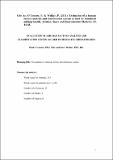| dc.contributor.author | O'Connor, Paul | |
| dc.date.accessioned | 2012-08-22T12:11:43Z | |
| dc.date.available | 2012-08-22T12:11:43Z | |
| dc.date.issued | 2011 | |
| dc.identifier.citation | O'Connor, P,Walker, P (2011) 'Evaluation of a Human Factors Analysis and Classification System as Used by Simulated Mishap Boards'. Aviation Space And Environmental Medicine, 82 :44-48. | en_US |
| dc.identifier.uri | http://hdl.handle.net/10379/2937 | |
| dc.description.abstract | O'CONNOR P, WALKER P. Evaluation of a Human Factors Analysis and Classification System as used by simulated mishap boards. Aviat Space Environ Med 2011; 82:44-8.Background: The reliability of the Department of Defense Human Factors Analysis and Classification System (DOD-HFACS) has been examined when used by individuals working alone to classify the causes of summary, or partial, information about a mishap. However, following an actual mishap a team of investigators would work together to gather and analyze a large amount of information before identifying the causal factors and coding them with DOD-HFACS. Method: There were 204 military Aviation Safety Officer students who were divided into 30 groups. Each group was provided with evidence collected from one of two military aviation mishaps. DOD-HFACS was used to classify the mishap causal factors. Results: Averaged across the two mishaps, acceptable levels of reliability were only achieved for 56.9% of nanocodes. There were high levels of agreement regarding the factors that did not contribute to the incident (a mean agreement of 50% or greater between groups for 91.0% of unselected nanocodes); the level of agreement on the factors that did cause the incident as classified using DOD-HFACS were low (a mean agreement of 50% or greater between the groups for 14.6% of selected nanocodes). Discussion: Despite using teams to carry out the classification, the findings from this study are consistent with other studies of DOD-HFACS reliability with individuals. It is suggested that in addition to simplifying DOD-HFACS itself, consideration should be given to involving a human factors/organizational psychologist in mishap investigations to ensure the human factors issues are identified and classified in a consistent and reliable manner. | en_US |
| dc.format | application/pdf | en_US |
| dc.language.iso | en | en_US |
| dc.relation.ispartof | Aviation Space And Environmental Medicine | en |
| dc.rights | Attribution-NonCommercial-NoDerivs 3.0 Ireland | |
| dc.rights.uri | https://creativecommons.org/licenses/by-nc-nd/3.0/ie/ | |
| dc.subject | DOD-HFACS | en_US |
| dc.subject | reliability | en_US |
| dc.subject | human factors | en_US |
| dc.subject | mishap classification | en_US |
| dc.subject | ACCIDENT ANALYSIS | en_US |
| dc.subject | HUMAN ERROR | en_US |
| dc.title | Evaluation of a Human Factors Analysis and Classification System as Used by Simulated Mishap Boards | en_US |
| dc.type | Article | en_US |
| dc.date.updated | 2012-03-22T10:57:25Z | |
| dc.identifier.doi | DOI 10.3357/ASEM.2913.2011 | |
| dc.local.publishedsource | http://dx.doi.org/10.3357/ASEM.2913.2011 | en_US |
| dc.description.peer-reviewed | peer-reviewed | |
| dc.contributor.funder | |~| | |
| dc.internal.rssid | 1127677 | |
| dc.local.contact | Paul O'Connor, Cisc, Nuig. Email: paul.oconnor@nuigalway.ie | |
| dc.local.copyrightchecked | Yes | |
| dc.local.version | ACCEPTED | |
| nui.item.downloads | 694 | |


